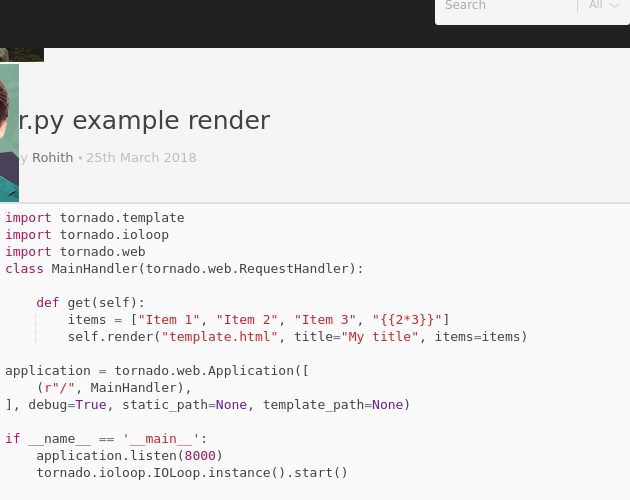
#RENDER JADE SNIPPIT CODE#
The following code snippet uses gulp, gulp-jade and gulp-replace node modules in a. The function accepts a second argument which is the jade runtime.I decided to modify the compiled function so: You should be able to simply include it within a jade template: As mentioned include can be used to include other content such as html or css. GLOBAL.jade = require('jade/lib/runtime') but it's not a good idea.


In node.js you can populate the GLOBAL object, i.e. Since these functions are compiled for client side, the compiled views depends on a global jade runtime (i.e. The template function accepts one argument which is for dynamic data. The runtime generates the attribute values and does other stuff like escaping values. A common use case for micro-templating is the creation of a category list that’s present on all pages in the Help Center. The Snippets tab, in the Navigator pane on the left, lists your Snippets. Jade Design and styling Updating page templates Rendering HTML using JavaScript When Zendesk’s Curlybars templating language can’t generate the desired HTML, our JavaScript-based micro-templating system steps in. js files consisting of a function named template, you need to use the jade runtime. The Console Drawer pops up to display the Hello, Snippets message that the Snippet logs, and the content of the webpage changes completely: Open the Snippets tab. In order to use the compiled views which are. Thanks to Jade, the latest express app that I had developed responded to the first request in more than 800ms, so as I didn't want to change the templating engine, I, just like you, decided to compile the Jade views on my development environment and deploy these files instead of original views. The jaderender function is a convenience wrapper that does both steps at once. The second step calls the closure with optionally some local variables to render the output to HTML. The binding for this is implemented in jadecompile. jade files must be put inside views folder in the root folder of Node.js application. The first step compiles the template with some formatting options into a closure.
#RENDER JADE SNIPPIT INSTALL#
Install jade into your project using NPM as below. Of course you can use the "cache view" feature of express on production that caches the compiled views, but the compiled views are stored in memory that can consume so much resources. It uses whitespace and indentation as a part of the syntax.

Jade (now Pug) is a great templating engine, but the compilation of the views consume so much resources.


 0 kommentar(er)
0 kommentar(er)
